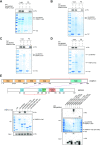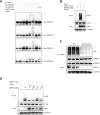MKRN3-mediated ubiquitination of Poly(A)-binding proteins modulates the stability and translation of GNRH1 mRNA in mammalian puberty
- PMID: 33744966
- PMCID: PMC8053111
- DOI: 10.1093/nar/gkab155
MKRN3-mediated ubiquitination of Poly(A)-binding proteins modulates the stability and translation of GNRH1 mRNA in mammalian puberty
Abstract
The family of Poly(A)-binding proteins (PABPs) regulates the stability and translation of messenger RNAs (mRNAs). Here we reported that the three members of PABPs, including PABPC1, PABPC3 and PABPC4, were identified as novel substrates for MKRN3, whose deletion or loss-of-function mutations were genetically associated with human central precocious puberty (CPP). MKRN3-mediated ubiquitination was found to attenuate the binding of PABPs to the poly(A) tails of mRNA, which led to shortened poly(A) tail-length of GNRH1 mRNA and compromised the formation of translation initiation complex (TIC). Recently, we have shown that MKRN3 epigenetically regulates the transcription of GNRH1 through conjugating poly-Ub chains onto methyl-DNA bind protein 3 (MBD3). Therefore, MKRN3-mediated ubiquitin signalling could control both transcriptional and post-transcriptional switches of mammalian puberty initiation. While identifying MKRN3 as a novel tissue-specific translational regulator, our work also provided new mechanistic insights into the etiology of MKRN3 dysfunction-associated human CPP.
© The Author(s) 2021. Published by Oxford University Press on behalf of Nucleic Acids Research.
Figures






References
-
- Tena-Sempere M. Keeping puberty on time: novel signals and mechanisms involved. Curr. Top. Dev. Biol. 2013; 105:299–329. - PubMed
-
- Shalev D., Melamed P.. The role of the hypothalamus and pituitary epigenomes in central activation of the reproductive axis at puberty. Mol. Cell. Endocrinol. 2020; 518:111031. - PubMed
-
- Latronico A.C., Brito V.N., Carel J.C.. Causes, diagnosis, and treatment of central precocious puberty. Lancet. Diabetes Endocrinol. 2016; 4:265–274. - PubMed
Publication types
MeSH terms
Substances
LinkOut - more resources
Full Text Sources
Other Literature Sources
Molecular Biology Databases
Miscellaneous

